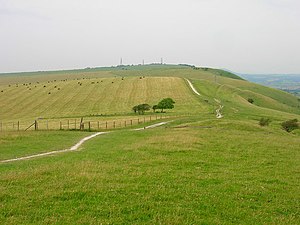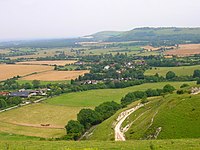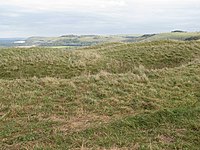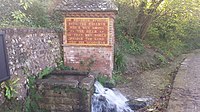Fulking
| Fulking | |
| Sussex | |
|---|---|
 Fulking from the South Downs Way | |
| Location | |
| Grid reference: | TQ247114 |
| Location: | 50°53’21"N, 0°13’38"W |
| Data | |
| Population: | 250 (2011) |
| Post town: | Henfield |
| Postcode: | BN5 |
| Dialling code: | 01273 |
| Local Government | |
| Council: | Mid Sussex |
| Parliamentary constituency: |
Arundel and South Downs |
| Website: | www.fulking.net |
Fulking is a village in Sussex, sitting on the north slopes of the South Downs, five miles north-west of Brighton, sandwiched between the Upper Beeding and Poynings parish. The downland scarp, which includes the Fulking and Perching bostals (paths), is part of the 'Beeding Hill to Newtimber Hill' designated Site of Special Scientific Interest.
Contents
History
Fulking was originally part of the parish of Edburton, but within the Poynings hundred of the Rape of Lewes. while Edburton itself is in the Burbeach Hundred of the Rape of Bramber.[1]
Fulking sits along the spring line at the Downs foot where the fertile band of Upper Greensand and Grey Chalk attracted early farmers to build a string of hamlets and villages including Fulking itself, Tottington, Truleigh, Edburton, Perching, Poynings and Newtimber.
As it has not been a parish of itself, Fulking has no Church of England church, and it remains part of the parish of Edburton, St Andrew's Church in the latter village.[2][3]
Fulking's old houses are a plum pudding of different types: one or two are made of local greensand, some are timber framed (like the Shepherd and Dog pub, under its stucco), some flint, some brick, one or two thatched, even one with a corrugated iron extension. The house are mainly expensive, but not exclusively and it has some council-built homes.
Since the Norman conquest one thousand years ago, the Crown Estate owned the Poynings Estate which covered around 4,000 acres including many farms in the Weald and on the Downs at Fulking, Poynings and Pyecombe. It was all sold between 1980 and 1984 to tenant farmers.
Abut the village
Edburton Castle Ring is a motte-and-bailey castle on Edburton Hill.[4] The earthworks and interior area of a castle believed to date from the immediate post-Conquest period, soon after October 1066.
Bowl barrows are to be found on Scabes Castle.[5] Today only a roughly oval mound is visible the monument's, having been levelled by modern ploughing on its eastern side. A bowl barrow on Fulking Hill is I the form of a circular mound which shows signs of part-excavation in the past.[6]
On Perching Hill is te site of a deserted mediæval settlement and associated cultivation terraces: downland was rarely inhabited during the mediæval period; the establishment of the settlement is probably due to the presence of an underground water course in the coombe, indicated by a well about 200 feet to the west of the monument.[7]
1886 Water supply system
A distinctive feature of Fulking is the remains of a late Nineteenth Century water supply system. A hydraulic ram, housed in small building near the Shepherd and Dog public house, pumped water from Fulking Hill to a reservoir at the western end of the village street, where a drinking fountain and water trough were provided. The water was then fed by gravity to two further reservoirs, supplying two hand pumps along the street.[8]
The building housing is a Grade II listed building.[9] The hydraulic ram bears the inscription:
'He sendeth springs into the valleys which run among the hills | Oh that men would praise the Lord for his goodness' (Psalm 104, verse 10 and Psalm 107, verse 8).
The drinking fountain is also listed.[10] and bears the inscription:
'To the glory of God | And in honour of John Ruskin | Psalm LXXVIII | That they might set their hope in God, and not forget the works of God | But keep his commandments | Who brought streams also out of the rock' (Psalm 58, verses 7 and 16)
The system was installed in 1886. Henry Willett, a wealthy brewer from Brighton, and John Ruskin are usually credited with devising and instigating the water supply scheme. However, contemporary newspaper accounts give credit for the scheme to Rev. F. Gell, rector to Edburton, with generous support from Henry Willet.[11][12] Ruskin himself, in a letter to Willet dated Brantwood, 16 June 1887, said 'I was grieved by your inscription on the fountain, for it made my name far too conspicuous, nor did I feel that the slightest honour was owing to me in the matter'.[13]
There are also two associated hand pumps in the village.[14][15]
Sport
- Cricket: Preston Nomads Cricket Club
Preston Nomads were founded in 1927 in Preston, in Brighton. When it was founded, the club did not have its own ground; hence the 'Nomads' element of the name. In 1937, Spenta (Spen) Cama, one of the founding members of the club, bought some fields in Fulking which formed the nucleus of the club's current ground, later expanded. The club's pavilion was opened in 1982.
Pictures
| ("Wikimedia Commons" has material about Fulking) |
Outside links
References
- ↑ Edburton: A History of Sussex: Victoria County Histories
- ↑ "St. Andrew's Church". Fulking Village. https://fulking.net/st-andrews-church/.
- ↑ A History of the County of Sussex - Volume 7 pp 202-204: Parishes: Fulking (Victoria County History)
- ↑ National Heritage List 1012171: Edburton Castle Ring (Scheduled ancient monument entry)
- ↑ National Heritage List 1014950: Bowl barrows on Scabes Castle (Scheduled ancient monument entry)
- ↑ National Heritage List 1014951: Bowl barrow on Fulking Hill (Scheduled ancient monument entry)
- ↑ National Heritage List 1015125: Deserted mediæval settlement and associated cultivation terraces on Perching Hill (Scheduled ancient monument entry)
- ↑ Fulking : Conservation Area Character Appraisal and Management Plan. Midhurst: South Downs National Park Authority. December 2019. https://www.southdowns.gov.uk/wp-content/uploads/2020/01/Fulking-CAAMP.pdf. Retrieved 23 February 2020.
- ↑ National Heritage List 1354830: The Stream Basin and Conduit-House (Grade II listing)
- ↑ National Heritage List 1334374: Reservoir, Drinking Fountain and Water Trough (Grade II listing)
- ↑ "Saunterings in Sussex". Brighton Gazette: p. 8. 10 September 1885.
- ↑ "Edburton : Welcome Improvements". Mid Sussex Times: p. 5. 16 March 1886.
- ↑ Cook, E. T.; Wedderburn, Alexander, eds. The works of John Ruskin : Volume 37. London: George Allen. p. 591. https://archive.org/details/worksofjohnruski37ruskiala/page/590/. Retrieved 23 February 2020.
- ↑ National Heritage List 1096867: Water Pump (Grade II listing)
- ↑ National Heritage List 1285792: The Village Pump (Grade II listing)













